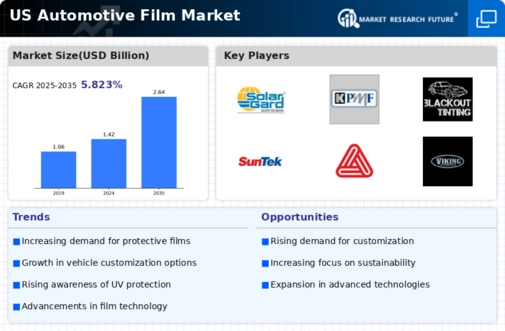The automotive film market is currently characterized by a dynamic competitive landscape, driven by innovation, technological advancements, and a growing emphasis on sustainability. Key players such as 3M (US), Llumar (US), and Xpel (US) are at the forefront, each adopting distinct strategies to enhance their market positioning. 3M (US) focuses on product innovation and sustainability, aiming to reduce environmental impact while improving performance. Llumar (US) emphasizes regional expansion and customer engagement, enhancing its distribution channels to reach a broader audience. Xpel (US) is heavily investing in digital transformation, leveraging online platforms to enhance customer experience and streamline operations. Collectively, these strategies contribute to a competitive environment that is increasingly focused on differentiation through quality and technological superiority.
In terms of business tactics, companies are localizing manufacturing and optimizing supply chains to enhance efficiency and responsiveness to market demands. The automotive film market appears moderately fragmented, with several key players exerting influence over various segments. This fragmentation allows for niche players to thrive, while larger companies leverage their scale to optimize production and distribution, thereby shaping the overall market structure.
In November 2025, 3M (US) announced the launch of a new line of eco-friendly automotive films designed to reduce energy consumption during production. This strategic move not only aligns with global sustainability trends but also positions 3M (US) as a leader in environmentally conscious manufacturing. The introduction of these products is likely to attract environmentally aware consumers, enhancing brand loyalty and market share.
In October 2025, Llumar (US) expanded its distribution network by partnering with several regional automotive retailers. This strategic partnership is expected to enhance product availability and customer access, thereby increasing sales potential. By strengthening its distribution channels, Llumar (US) is likely to improve its competitive edge in a market that values accessibility and customer service.
In September 2025, Xpel (US) launched an advanced online platform that integrates AI-driven customer support and product customization options. This initiative reflects a significant investment in digital transformation, aiming to enhance user experience and streamline the purchasing process. By adopting such technology, Xpel (US) is likely to attract a tech-savvy customer base, further solidifying its market position.
As of December 2025, current trends in the automotive film market indicate a strong shift towards digitalization, sustainability, and AI integration. Strategic alliances among key players are shaping the competitive landscape, fostering innovation and collaboration. The focus appears to be shifting from price-based competition to differentiation through technological advancements and supply chain reliability. Moving forward, companies that prioritize innovation and sustainability are likely to gain a competitive advantage, as consumers increasingly favor products that align with their values.





















Leave a Comment